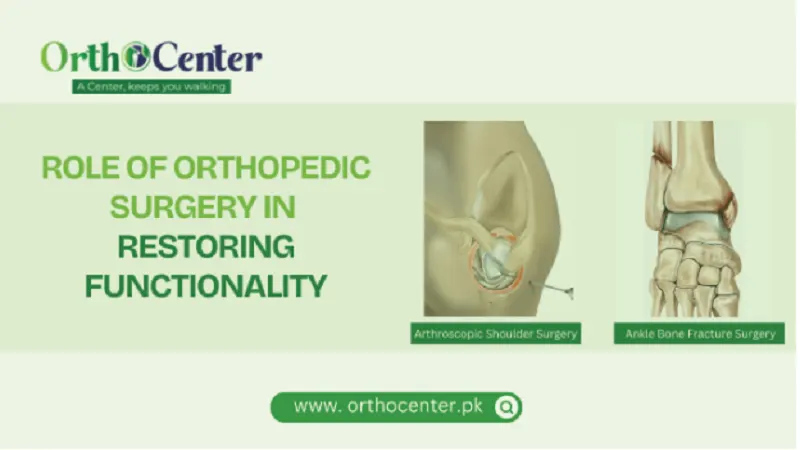Orthopedic surgery improves limb function, reduces pain and distress, and works for the treatment of the affected limb of the patient. For congenital deformity, sports injury, or a degenerative condition, orthopedic surgery brings hope to many individuals. Procedures like precise and effective ankle bone surgery and arthroscopic shoulder surgery are some of the main orthopedic procedures. Orthopedic surgery is a broad area of surgical treatments focused on helping people with problems related to their bones, joints, and muscles. However, the newly designed techniques and technology are benefiting young people with outstanding healthcare services that give excellent and positive results. Moreover, these techniques also help patients recover quickly with minimal complications.
This article briefly explains the role of orthopedic surgery in regaining body functionality.
Orthopedic Surgeries Are Broadly Classified Into Two Types
- Reconstructive surgery encompasses surgical procedures like joint replacement and spinal fusion because of their focus on the stability of structures.
- Trauma Surgery includes surgical operations that involve fixing bone fractures or solving joint dislocations due to an accident or an injury.
Surgical Techniques
Open Reduction and Internal Fixation (ORIF)
This surgical procedure repositions the parts of the broken bone and fixes them using plates, screws, or rods. It is especially effective in fractures that require more than simple conservative treatment, which involves splinting or casting of the affected limb.
External Fixation
In serious conditions, the doctor uses an external fixator to hold the broken bone in the right place as it heals. This method works intermittently before a definite internal fixation.
Arthroscopic Shoulder Surgery
The shoulder is a ball-and-socket joint that allows free movement and is easily affected by injuries and arthritis. Hence, shoulder arthroscopy is a keyhole surgery used to treat problems related to the rotator cuff, labral tears, and frozen shoulder.
Ankle Bone Fracture Surgery
Fractures of the ankle are well-known conditions resulting from trauma, falls, or sports activities. Bone injuries can vary quite a bit. Some might be just small cracks, while others could result in multiple broken pieces. The severity of these injuries can also differ greatly. Inadequate treatment may lead to potential complications such as joint instability or arthritis.
Rotator Cuff Repair
Ruptured tendons are repaired by reconnecting them to the bone using sutures and anchors.
Labral Repair
However, in the shoulder, the labral is a cartilage ring that needs to be repaired to provide stability.
Removal of Bone Spurs
It involves trimming off all the extra growth that causes impingement and pain to the patient.
Other Orthopedic Surgeries
Joint replacement surgery is one of the other common orthopedic operations. It typically involves the whole hip or knee replacement surgery and is performed to help patients relieve their pain and gain mobility. Carpal tunnel surgery is also another surgical operation that works by reducing wrist pain and numbness.
So, it becomes convenient to move your hands without any discomfort. Moreover, you can fix a tear of the knee ligament, a common injury associated with sports, with ACL reconstruction surgery. On the other hand, meniscus repair fixes the knee joint. However, all these surgeries, along with physical therapy, aim to strengthen muscles and help people regain their ability to move and function well.
Restoring Functionality
Rehabilitation after the surgical procedure helps to achieve correct positioning, joint stability, and motion. Initial mobilization and physical therapy help to diminish dangerous and recurrent stiffness and chronic pain.
Key Benefits of Orthopedic Surgery in Restoring Health and Mobility
Orthopedic operations play a pivotal role in restoring essential body functions by addressing issues related to bones, joints, muscles, and ligaments. These surgeries, such as joint replacements and tendon repairs, alleviate pain, improve mobility, and enhance overall functionality, enabling individuals to lead active, healthier lives and regain their physical independence effectively.
Restoration of Mobility
Operations like hip replacements, knee replacements, or fracture surgeries actually assist in repairing bones or worn-out joints in our bodies.
Pain Management
Orthopedic conditions can cause chronic pain. Therefore, arthroscopic surgery helps the doctor to locate and treat the source of joint pain. This involves helping to strengthen a joint or fixing a damaged ligament or cartilage. Moreover, it aims to relieve pain, allowing patients to regain their quality of life and enjoy everyday activities again.
Enhanced Quality of Life
Orthopedic surgery enables patients to regain the ability to engage in such activities, work, and live freely without help.
Prevention of Long-term Complications
If an injury or a degenerative condition is untreated, the long-term effects can be joint deformities, arthritis, or muscle atrophy. However, the role of orthopedic surgery is to help avoid such complications by allowing appropriate positioning and movement of the musculoskeletal system.
Conclusion
Orthopedic surgery is one of the most important fields of surgery in the present era, and it consists of operations that concern different muscular and skeletal abnormalities. Such procedures include ankle bone fracture surgery and arthroscopic shoulder surgery, which can assist individuals in getting their motion back, alleviating the pain they feel, and improving their lives. However, with increasing improvements in technology and techniques in executing surgical procedures, orthopedic surgery is on track to helping millions more of those in need, improve their quality of life and live healthier, active lives globally.
See More:https://healthviralblog.org/
